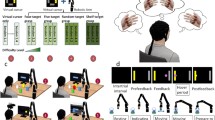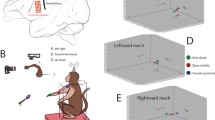Abstract
A Brain–Computer Interface (BCI) is a device that transforms brain signals, which are intentionally modulated by a user, into control commands. BCIs based on motor imagery (MI) and steady-state visual evoked potentials (SSVEP) can partially restore motor control in spinal cord injured patients. To determine whether these BCIs can be combined for grasp and elbow function control independently, we investigated a control method where the beta rebound after brisk feet MI is used to control the grasp function, and a two-class SSVEP-BCI the elbow function of a 2 degrees-of-freedom artificial upper limb. Subjective preferences for the BCI control were assessed with a questionnaire. The results of the initial evaluation of the system suggests that this is feasible.





Similar content being viewed by others
References
Allison BZ, Brunner C, Kaiser V, Müller-Putz GR, Neuper C, Pfurtscheller G (2010) Toward a hybrid brain-computer interface based on imagined movement and visual attention. J Neural Eng 7:026007
Bin G, Gao X, Yan Z, Hong B, Gao S (2009) An online multi-channel SSVEP-based brain-computer interface using a canonical correlation analysis method. J Neural Eng 6:1–6
Birbaumer N, Ghanayim N, Hinterberger T, Iversen I, Kotchoubey B, Kübler A, Perelmouter J, Taub E, Flor H (1999) A spelling device for the paralysed. Nature 98:297–298
Cheng M, Gao X, Gao S, Xu D (2002) Design and implementation of a brain-computer interface with high transfer rates. IEEE Trans Neural Syst Rehab Eng 49:1181–1186
Davison AC, Hinkley DV (1997) Bootstrap methods and their application. Cambridge University Press, London
Donchin E, Spencer KM, Wijesinghe R (2000) The mental prosthesis: assessing the speed of a P300-based brain-computer interface. IEEE Trans Neural Syst Rehab Eng 8:174–179
Gao X, Xu D, Cheng M, Gao S (2003) A BCI-based environmental controller for the motion-disabled. IEEE Trans Neural Syst Rehab Eng 11:137–140
Graimann B, Huggins JE, Levine SP, Pfurtscheller G (2002) Visualization of significant ERD/ERS patterns in multichannel EEG and ECoG datas. Clin Neurophysiol 113:43–47
Hjorth B (1975) An on-line transformation of EEG scalp potentials into orthogonal source derivations. Electroencephalogr Clin Neurophysiol 39:526–530
Horki P, Neuper C, Müller-Putz GR (2010) Asynchronous steady-state visual evoked potential based BCI: control of a 2 DoF artificial upper limb. Biomed Tech 55(6):367–374
Hotelling H (1936) Relations between two sets of variates. Biometrika 28:321–377
Kübler A, Neumann N, Wilhelm B, Hinterberger T, Birbaumer N (2004) Predictability of brain-computer communication. J Psychophysiol 18(2):121–129
Lin Z, Zhang C, Wu W, Gao X (2007) Frequency recognition based on canonical correlation analysis for ssvep-based bcis. IEEE Trans Biomed Eng 54(6):1172–1176
Makeig S, Debener S, Onton J, Delorme A. (2004) Mining event-related brain dynamics. Trends Cogn Sci 8:204–210
McMillan GR, Calhoun GL, Middendorf MS, Schnurer JH, Ingle DF, Nasman VT (1995) Direct brain interface utilizing self-regulation of steady-state visual evoked response (SSVER). In: Proceedings of the RESNA 18th annual conference (RESNA)
Middendorf M, McMillan G, Calhoun G, Jones KS (2000) Brain-computer interfaces based on the steady-state visual-evoked response. IEEE Trans Rehab Eng 8:211–214
Müller-Putz GR, Pfurtscheller G (2008) Control of an electrical prosthesis with an SSVEP-based BCI. IEEE Trans Biomed Eng 55:361–364
Müller-Putz GR, Scherer R, Brauneis C, Pfurtscheller G (2005) Steady-state visual evoked potential (SSVEP)-based communication: impact of harmonic frequency components. J Neural Eng 2:1–8
Müller-Putz GR, Scherer R, Pfurtscheller G, Rupp R (2005) EEG-based neuroprosthesis control: a step towards clinical practice. Neurosci Lett 382:169–174
Müller-Putz GR, Eder E, Wriessnegger SC, Pfurtscheller G (2008) Comparison of DFT and lock-in amplifier features and search for optimal electrode positions in SSVEP-based BCI. J Neurosci Meth, 168:174–181
Müller-Putz GR, Kaiser V, Solis-Escalante T, Pfurtscheller G (2010) Fast set-up asynchronous brain-switch based on detection of foot motor imagery in 1-channel EEG. Med Biol Eng Comput
Müller-Putz GR, Scherer R, Pfurtscheller G, Neuper C (2010) Temporal coding of brain patterns for direct limb control in humans. Front Neurosci/Neuroprost
Ortner R, Allison BZ, Korisek G, Gaggl G, Pfurtscheller G (2011) An SSVEP BCI to Control a Hand Orthosis for Persons With Tetraplegia. IEEE Trans Neural Syst Rehab Eng, 19(1):1–5
Pfurtscheller G, Lopes da Silva FH (1999) Event-related EEG/MEG synchronization and desynchronization: basic principles. Clin Neurophysiol 110:1842–1857
Pfurtscheller G, Solis-Escalante T (2009) Could the beta rebound in the EEG be suitable to realize a “brain switch”? Clin Neurophysiol 120:24–29
Pfurtscheller G, Neuper C, Guger C, Harkam W, Ramoser H, Schlögl A, Obermaier B, Pregenzer M (2000) Current trends in Graz brain-computer interface (BCI) research. IEEE Trans Rehab Eng 8:216–219
Pfurtscheller G, Müller GR, Pfurtscheller J, Gerner HJ, Rupp R (2003) “Thought”-control of functional electrical stimulation to restore handgrasp in a patient with tetraplegia. Neurosci Lett 351:33–36
Pfurtscheller G, Allison BZ, Brunner C, Bauernfeind G, Solis-Escalante T, Scherer R, Zander TO, Müller-Putz G, Neuper C, Birbaumer N (2010) The hybrid BCI. Front Neurosci 4:30
Pfurtscheller G, Solis-Escalante T, Ortner R, Linortner P, Müller-Putz GR (2010) Self-paced operation of an SSVEP-based orthosis with and without an imagery-based “brain switch”: a feasibility study towards a hybrid BCI. IEEE Trans Neural Syst Rehab Eng 18:409–414
Pudil P, Novovicová J, Kittler J (1994) Floating search methods in feature selection. Patt Rec Lett 15(11):1119–1125
Regan D (1989) Human brain electrophysiology: evoked potentials and evoked magnetic fields in science and medicine. Elsevier, New York
Solis-Escalante T, Müller-Putz GR, Brunner C, Kaiser V, Pfurtscheller G (2010) Analysis of sensorimotor rhythms for the implementation of a brain switch for healthy subjects. Biomed Sig Proc Con 5:15–20
Vilimek R, Zander TO (2009) Universal access in human-computer interaction. Intelligent and ubiquitous interaction environments, chapter BC (eye): combining eye-gaze input with brain-computer interaction. Springer, Berlin/Heidelberg, pp 593–602
Wolpaw JR, Birbaumer N, McFarland DJ, Pfurtscheller G, Vaughan TM (2002) Brain-computer interfaces for communication and control. Clin Neurophysiol 113:767–791
Zhang D, Maye A, Gao X, Hong B, Engel AK, Gao S (2010) An independent brain-computer interface using covert non-spatial visual selective attention. J Neural Eng 7:016010
Acknowledgments
This work was supported by EU COST Action BM0601 (Neuromath) and Wings for Life - Spinal Cord Research Foundation (WFL-SE-016/09). We are indebted to V. Kaiser and L. Deuse for assistance in data recording.
Author information
Authors and Affiliations
Corresponding author
Electronic supplementary material
Below is the link to the electronic supplementary material.
Rights and permissions
About this article
Cite this article
Horki, P., Solis-Escalante, T., Neuper, C. et al. Combined motor imagery and SSVEP based BCI control of a 2 DoF artificial upper limb. Med Biol Eng Comput 49, 567–577 (2011). https://doi.org/10.1007/s11517-011-0750-2
Received:
Accepted:
Published:
Issue Date:
DOI: https://doi.org/10.1007/s11517-011-0750-2




